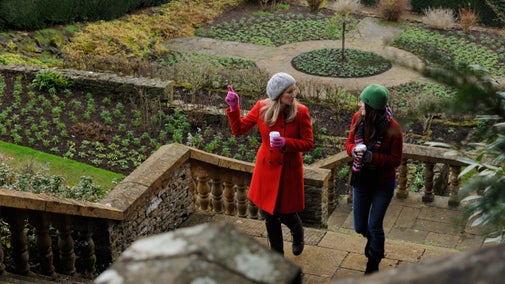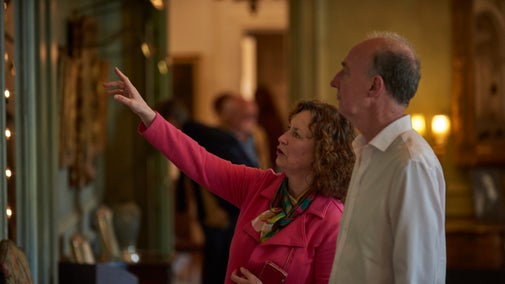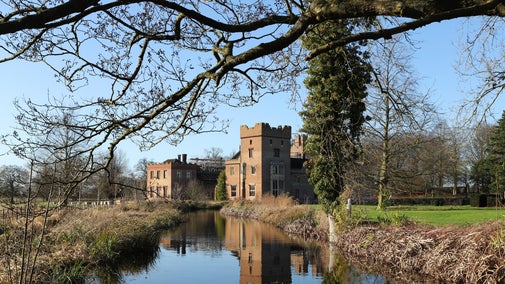
Donate
Everyone needs nature, now more than ever. Donate today and you could help people and nature to thrive at the places we care for.

We work hard to look after Upton House and Gardens and there's always a project on the go. Take a look at the work we do to look after this place for everyone, for ever.
At Upton we use both remedial conservation and preventative conservation. When you visit you can find out why we put teasels on the chairs and why we don't use gloves when cleaning porcelain.
We protect artefacts in the house from irreversible damage from light and maintain the house as a welcoming home rather than a museum. There are five agents of decay that the collections and house team regularly look out for when undertaking conservation work:
After a 13-month project the precious contents of the Picture Gallery are now protected from ultra-violet light and infrared radiation by high-tech roof glazing. Just as important, it is also weatherproof, unlike its predecessor.
The replaced roof light was designed for the squash court, which was the original purpose of this room. However, the original 1930s appearance was preserved, so to many eyes nothing will have changed – except for the better.

A management scheme is in place in which the garden areas open rotate as they come into season. Throughout the winter and early spring, the visitor route follows hard pathways, which show off the best of the spring bulbs. During this time, visitors view other areas of the garden at a distance, which enables you to truly appreciate the structure of the plants.
In May, the flowering of the first early herbaceous border marks the start of opening the wider garden beyond the Winter Walk, including the herbaceous terraces and the Bog Garden; the cycles then continue across the year.
Between November and March, visits to the garden are via the Winter Walk, which includes the hard footpath alongside the Mirror Pool and track through the woodland. Because of the location on the edge of an Ice Age valley, and the steepness of the historic grass paths, the grass wears away and the clay soil becomes compacted and waterlogged. This has serious implications for the much-loved garden and visitor safety. The joy of the Winter Walk lies in the open views into the heart of the garden and to the surrounding countryside.
Upton's 12 acres require the attention of a handful of permanent gardeners and dozens of volunteer helpers. Although the imprints of previous owners over the centuries remain evident, the gardens are largely as they were in the 1930s when Kitty Lloyd-Jones redesigned them alongside input from the family, particularly Lady Bearsted.
An orchard, herbaceous borders, vegetable garden, bog garden, wild areas and extensive grassed areas all pose a variety of challenges which the garden team work hard to maintain.

Ash dieback is a fungal disease called Hymenoscyphus fraxineus, that's having a devastating effect on the common ash, a UK native tree. They're part of the natural woodland planting throughout the property at Upton House and Gardens. There is evidence that most semi-mature trees less than 100 years old will die of the fungal disease, which is spore spread and windblown, so protection of the species is very limited.
Conserving the wider habitat in the gardens at Upton House includes monitoring the spread and effects of ash dieback. Close maintenance allows the team to ensure damage can be kept to a minimum, and the gardens can continue to be explored safely by visitors.
With your ongoing support, we're able to continue our vital conservation work. Thank you for helping to protect these special places.

Everyone needs nature, now more than ever. Donate today and you could help people and nature to thrive at the places we care for.
Visit Upton's historic garden and marvel at the view that unfolds in front of you. Discover the Mirror Pool and views from the south lawn.

Immerse yourself in one of the finest art collections in 20th-century England, which was the country house and weekend retreat of 2nd Viscount Bearsted, Walter Samuel.

Bring your group to visit Upton House and Gardens, see the famous art collection, enjoy the beautiful gardens or hear stories of Upton's history as a home.

Read about our strategy, which focuses on restoring nature, ending unequal access and inspiring more people.

We believe that nature, beauty and history are for everyone. That’s why we’re supporting wildlife, protecting historic sites and more. Find out about our work.
